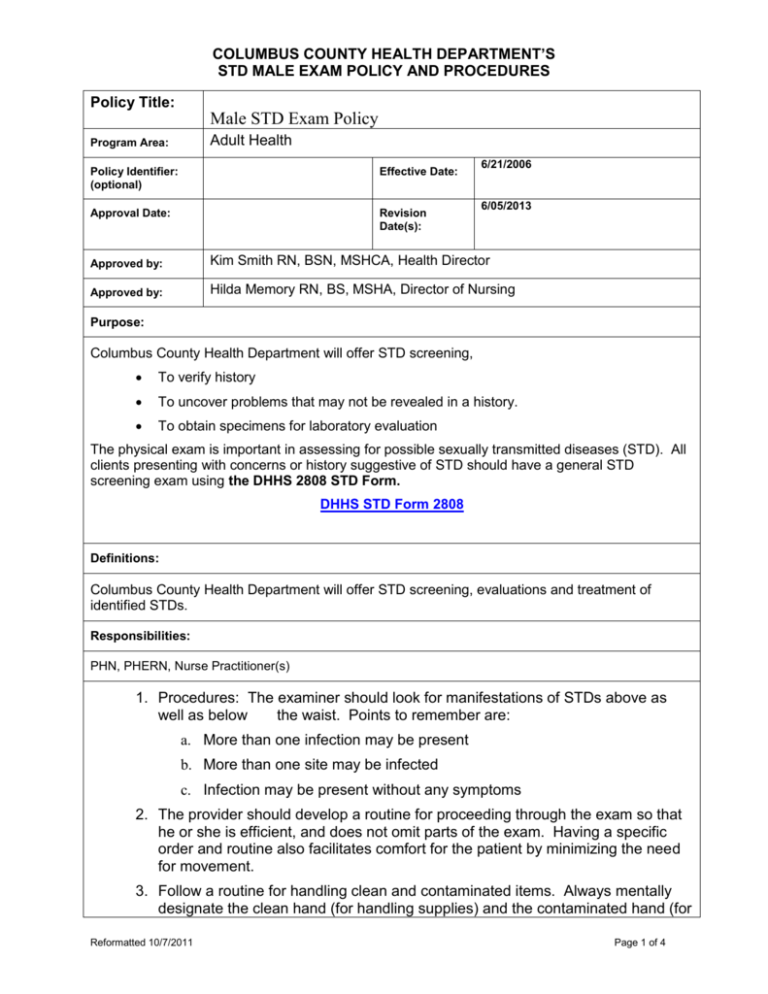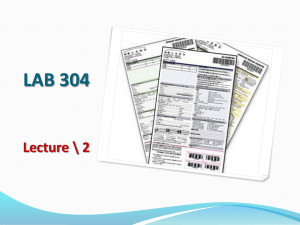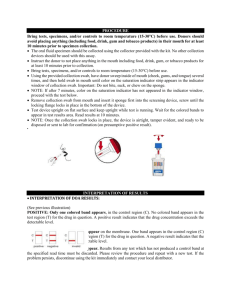STD Male Exam Policy
advertisement

COLUMBUS COUNTY HEALTH DEPARTMENT’S STD MALE EXAM POLICY AND PROCEDURES Policy Title: Male STD Exam Policy Adult Health Program Area: Policy Identifier: (optional) Effective Date: Approval Date: Revision Date(s): 6/21/2006 6/05/2013 Approved by: Kim Smith RN, BSN, MSHCA, Health Director Approved by: Hilda Memory RN, BS, MSHA, Director of Nursing Purpose: Columbus County Health Department will offer STD screening, To verify history To uncover problems that may not be revealed in a history. To obtain specimens for laboratory evaluation The physical exam is important in assessing for possible sexually transmitted diseases (STD). All clients presenting with concerns or history suggestive of STD should have a general STD screening exam using the DHHS 2808 STD Form. DHHS STD Form 2808 Definitions: Columbus County Health Department will offer STD screening, evaluations and treatment of identified STDs. Responsibilities: PHN, PHERN, Nurse Practitioner(s) 1. Procedures: The examiner should look for manifestations of STDs above as well as below the waist. Points to remember are: a. More than one infection may be present b. More than one site may be infected c. Infection may be present without any symptoms 2. The provider should develop a routine for proceeding through the exam so that he or she is efficient, and does not omit parts of the exam. Having a specific order and routine also facilitates comfort for the patient by minimizing the need for movement. 3. Follow a routine for handling clean and contaminated items. Always mentally designate the clean hand (for handling supplies) and the contaminated hand (for Reformatted 10/7/2011 Page 1 of 4 COLUMBUS COUNTY HEALTH DEPARTMENT’S STD MALE EXAM POLICY AND PROCEDURES touching the lesions, genitalia and contaminated items) and keep these consistent throughout the exam. 4. Before proceeding with the exam: a. Collect all necessary supplies in a location convenient to the exam process to facilitate efficiency and avoid contamination. b. Have ready the appropriate lab requisition forms. c. Label all slides, plates and vials. d. Assess patient’s understanding of the process and clarify his role. e. Allow privacy for disrobing. Supplies 1. Routine supplies: gloves, penlight or flashlight, adjustable lamp, tongue depressor, sterile Dacron-tipped swabs, sterile calcium alginate tipped swabs, pen/pencil to label vials and slides, state and local lab requisition forms as indicated, sterile gauze, gonorrhea culture plates, glass slides, & cover slips for slides. 2. Optional supplies: Venipuncture equipment and herpes culture transport media. 5. Components of the exam a. Observation of general appearance b. Inspection of the skin & hair c. Inspection of the oropharynx d. Palpation of lymph nodes e. Inspection of the genitalia f. Rectal exam, when indicated 6. Procedures for physical exam a. While proceeding through the exam process, always: Include attention to the patient’s emotional and physical comfort Explain to the patient what you are doing and why, as well as what you did Reassure when appropriate Observe universal precautions with all patients b. Begin the exam with the patient sitting upright on the table with shirt removed for upper body inspection, then follow with genital exam. 7. Upper body procedures a. Inspect the pharynx and oral mucosa with a light source for sores, pustules or inflammation. Lesions or patches are suggestive of syphilis, herpes or HIV that may be on gum lines, buccal mucosa, palate and the top or bottom of the tongue. b. Collect a specimen from the throat for gonorrhea culture when the history includes oral sex within the last three months. (See “Specimen Collection”). c. Inspect the scalp, brows and lashes for: Nits associated with pubic lice Reformatted 10/7/2011 Page 2 of 4 COLUMBUS COUNTY HEALTH DEPARTMENT’S STD MALE EXAM POLICY AND PROCEDURES Hair loss suggestive of syphilis Palpate lymph nodes beginning with the cervical nodes in the neck area and moving to supraclavicular, axillary, and epitrochlear. e. Inspect the skin for rashes, discoloration, or lesions. Begin with the face, then arms, hands, chest, back Inspect soles of the feet if syphilis is suspected d. Have patient put shirt back on; prepare for the genital exam. 8. Genital exam procedures a. The male genital exam proceeds more effectively with the male in a standing position, facing the examiner. Instruct the patient to lower pants and underwear and lean back against the exam table. Assure light source is appropriately positioned for adequate visualization. Palpate the groin nodes for swelling or tenderness. Inspect the skin and hair around the base of the penis for nits, lice, or lesions. Inspect the top and bottom of the penis, retracting the foreskin if present. Look for redness, sores, warts or other lesions and discharge from the meatal opening. Collect specimens for gram stain, gonorrhea culture. Inspect the skin of the scrotum for lesions or rashes, making sure to lift to see the posterior surface. Palpate the scrotal contents by gently compressing between the thumb and first two fingers. Note any swelling, tenderness, and the shape and size of any mass as you palpate the testes and the spermatic cords. This is a good point in the exam to assess the patient’s understanding of the importance of self-testicular exam and how to do it. Examine the rectum when the history includes rectal exposure or symptoms. Have the patient turn around and lean over the exam table. Examine the perianal area, anus, buttocks, and skin folds for inflammation, rashes, sores, warts or other lesions. 9. Specimen collection d. a. Collection of a specimen from the pharynx and or rectum for gonorrhea only culture on Monday – Friday Use Copan collection kit. Label the specimen tube provided in the kit For a throat specimen use a sterile Dacron-tipped swab and swab the back of the throat and tonsillar crypts. For a rectal specimen insert a sterile Dacron-tipped swab 2-3 cm into the anal canal, pressing laterally to avoid fecal matter If there is a significant fecal matter on the swab, discard and collect another specimen, pressing laterally. Take to lab to be sent to State Lab. Reformatted 10/7/2011 Page 3 of 4 COLUMBUS COUNTY HEALTH DEPARTMENT’S STD MALE EXAM POLICY AND PROCEDURES b. Collection of a specimen from the penis for gonorrhea only culture Monday, Tuesday, Wednesday. Use a Agar GC-Lect media plate for specimen collection Label media plate with patient name Insert a sterile calcium alginate-tipped swab 1-2 cm into urethral opening and rotate 3-5 seconds Roll swab in Z pattern on the Agar culture plate Take to the lab for in house processing. C. Collection of a specimen from the penis for gonorrhea only culture Thursday and Friday. Use Copan collection kit. Label the specimen tube provided in the kit Insert the sterile Dacron swab 1-2 cm into urethral opening and rotate 3-5 seconds Place the swab in the tube provided Take to the lab to be sent to Lab Corp. D. Collection of a specimen for herpes culture from vesicular or pustular lesions: 1. Vesicular or Pustular Lesions Open the vesicle with an 18 gauge needle. When collecting specimen use a Dacron cotton-tipped swab. Place the swab in the labeled viral transport media immediately and refrigerate until transported. 2. Crusted Lesions Remove the crust of the lesion with moistened gauze Swab the base of the lesion with a Dacron swab. Avoid making the lesion bleed. Place the swab in the viral labeled transport media immediately and refrigerate until transported. Laws and Rules: 10 A NCAC 41 A Article 6 NC General Statutes Chapter 130A-139 Reference(s): NC STD Manual Reference Guide to Selected Practice Requirements Reformatted 10/7/2011 Page 4 of 4





